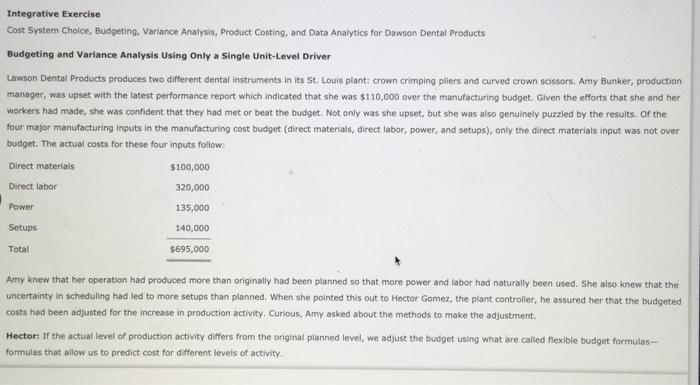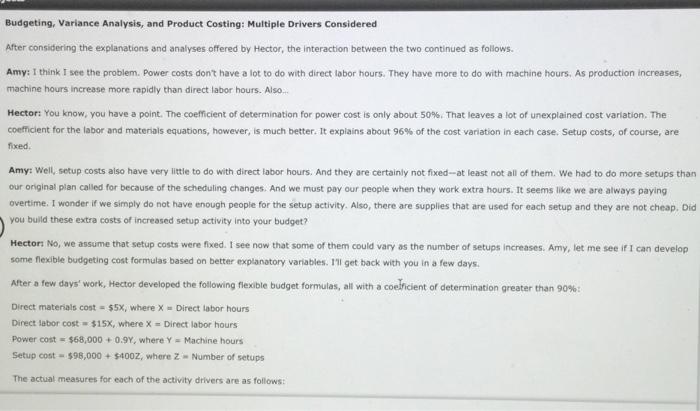Answered step by step
Verified Expert Solution
Question
1 Approved Answer
this is some information from the first half i need help with the second half second half: question 5 Integrative Exercise Cost 5 ystem Choice,
this is some information from the first half i need help with the second half 


Integrative Exercise Cost 5 ystem Choice, Budgeting, Variance Analysis, Product Costing, and Data Analytics for Dawson Dental Products Budgeting and Variance Analysis Using Only a Single Unit-Level Driver Lawson Dental Products produces two different dental instruments in its St. Louis plant: crown crimping pliers and curved crown scissors. Amy Bunker, production manager, was upset with the latest performance report which indicated that she was $110,000 over the manufacturing budget. Given the efforts that she and her workers had made, she was confident that they had met or beat the budget. Not only was she upset, but she was also genuinely puzzled by the results. of the. four major manufacturing inputs in the manufacturing cost budget (direct materials, direct labor, power, and setups), only the direct materials input was not over budget. The actual costs for these four inputs follow: Amy knew that her operation had produced more than originally had been planned so that more power and labor had naturally been used. She also knew that the uncertainty in scheduling had led to more setups than planned. When she pointed this out to Hector Gomez, the plant controller, he assured her that the budgeted costs had been adjusted for the increase in production activity. Curious, Amy asked about the methods to make the adjustment. Hector: If the actual level of production activity differs from the original planned level, we adjust the budget using what are called flexible budget formulas formulas that allow us to predict cost for different levels of activity. Budgeting, Variance Analysis, and Product Costing: Multiple Drivers Considered After considering the explanations and analyses offered by Hector, the interaction between the two continued as follows. Amy: I think I see the problem. Power costs don' have a lot to do with direct labor hours. They have more to do with machine hours, As production increases, machine hours increase more rapidly than direct labor hours. Also... Hector: You know, you have a point. The coefficient of determination for power cost is only about 50%. That leaves a lot of unexplained cost varlation. The coefficient for the labor and materials equations, however, is much better. It explains about 96% of the cost variation in each case. Setup costs, of course, are fixed. Amy: Well, setup costs aiso have very little to do with direct labor hours. And they are certainly not fixed-at least not all of them. We had to do more setups than our original plan called for because of the scheduling changes. And we must pay our people when they work extra hours. It seems like we are always paying overtime. I wonder if we simply do not have enough people for the setup activity. Also, there are supplies that are used for each setup and they are not cheap. Did you bulld these extra costs of increased setup activity into your budget? Hector: No, we assume that setup costs were fixed. I see now that some of them could vary as the number of setups increases. Amy, let me see if I can develop some flexible budgeting cost formulas based on better explanatory variables. I7l get back with you in a few days. After a few days' work, Hector developed the following flexble budget formulas, all with a coetficient of determination greater than 90% : Direct materials cost =$5x, where x= Direct labor hours Direct labor cost =$15X, where X= Direct labor hours Power cost =$68,000+0.9Y, where Y= Machine hours Setup cost =$98,000+$400Z, where Z= Number of setups The actual measures for each of the activity drivers are as follows: 5. Using the newly developed formulas, calculate what the costs should have been for the actual measures of activity for each of the four manufacturing activities. What are the total after-the-fact budgeted manufacturing costs? How does this compare with the total expected costs calculated in Requirement 1? The expected costs are 1 higher than those of Requirement 1 giving a much formulas gave. benchmark than the single-driver flexible budget Integrative Exercise Cost 5 ystem Choice, Budgeting, Variance Analysis, Product Costing, and Data Analytics for Dawson Dental Products Budgeting and Variance Analysis Using Only a Single Unit-Level Driver Lawson Dental Products produces two different dental instruments in its St. Louis plant: crown crimping pliers and curved crown scissors. Amy Bunker, production manager, was upset with the latest performance report which indicated that she was $110,000 over the manufacturing budget. Given the efforts that she and her workers had made, she was confident that they had met or beat the budget. Not only was she upset, but she was also genuinely puzzled by the results. of the. four major manufacturing inputs in the manufacturing cost budget (direct materials, direct labor, power, and setups), only the direct materials input was not over budget. The actual costs for these four inputs follow: Amy knew that her operation had produced more than originally had been planned so that more power and labor had naturally been used. She also knew that the uncertainty in scheduling had led to more setups than planned. When she pointed this out to Hector Gomez, the plant controller, he assured her that the budgeted costs had been adjusted for the increase in production activity. Curious, Amy asked about the methods to make the adjustment. Hector: If the actual level of production activity differs from the original planned level, we adjust the budget using what are called flexible budget formulas formulas that allow us to predict cost for different levels of activity. Budgeting, Variance Analysis, and Product Costing: Multiple Drivers Considered After considering the explanations and analyses offered by Hector, the interaction between the two continued as follows. Amy: I think I see the problem. Power costs don' have a lot to do with direct labor hours. They have more to do with machine hours, As production increases, machine hours increase more rapidly than direct labor hours. Also... Hector: You know, you have a point. The coefficient of determination for power cost is only about 50%. That leaves a lot of unexplained cost varlation. The coefficient for the labor and materials equations, however, is much better. It explains about 96% of the cost variation in each case. Setup costs, of course, are fixed. Amy: Well, setup costs aiso have very little to do with direct labor hours. And they are certainly not fixed-at least not all of them. We had to do more setups than our original plan called for because of the scheduling changes. And we must pay our people when they work extra hours. It seems like we are always paying overtime. I wonder if we simply do not have enough people for the setup activity. Also, there are supplies that are used for each setup and they are not cheap. Did you bulld these extra costs of increased setup activity into your budget? Hector: No, we assume that setup costs were fixed. I see now that some of them could vary as the number of setups increases. Amy, let me see if I can develop some flexible budgeting cost formulas based on better explanatory variables. I7l get back with you in a few days. After a few days' work, Hector developed the following flexble budget formulas, all with a coetficient of determination greater than 90% : Direct materials cost =$5x, where x= Direct labor hours Direct labor cost =$15X, where X= Direct labor hours Power cost =$68,000+0.9Y, where Y= Machine hours Setup cost =$98,000+$400Z, where Z= Number of setups The actual measures for each of the activity drivers are as follows: 5. Using the newly developed formulas, calculate what the costs should have been for the actual measures of activity for each of the four manufacturing activities. What are the total after-the-fact budgeted manufacturing costs? How does this compare with the total expected costs calculated in Requirement 1? The expected costs are 1 higher than those of Requirement 1 giving a much formulas gave. benchmark than the single-driver flexible budget 
second half:


question 5
Step by Step Solution
There are 3 Steps involved in it
Step: 1

Get Instant Access to Expert-Tailored Solutions
See step-by-step solutions with expert insights and AI powered tools for academic success
Step: 2

Step: 3

Ace Your Homework with AI
Get the answers you need in no time with our AI-driven, step-by-step assistance
Get Started


